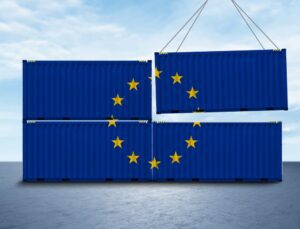Excerpt from paper by Chad P. Bown & Kathleen Claussen published by the Peterson Institute for International Economics.
The US-Mexico-Canada Agreement (USMCA) introduced a new compliance institution for labor rights in trade agreements: the facility-specific Rapid Response Labor Mechanism (RRM). The RRM was developed to tackle one particular thorn in the side of North American integration—labor rights for Mexican workers—which had had detrimental, long-term political-economic consequences for the two countries’ trade relationship. This paper reviews the unique political-economic moment in the United States and Mexico that prompted the creation of this tool. It describes how the RRM works and the considerable financial and human resources the two governments have brought to bear to operationalize it. The paper then reports a number of stylized facts on how governments used the RRM during its first three years, largely in the auto sector. It proposes paths of potentially fruitful political-economic research to understand the full implications of the RRM and concludes with preliminary lessons as well as a discussion of the potential for policymakers to transpose facility-specific mechanisms for labor or other issues, such as the environment, into future economic agreements…
…With only 11 uses in the first three years of the RRM, data with which to evaluate the mechanism remain scarce. Many aspects of how the RRM works are unknown and difficult to evaluate. For example, the data reveal little about whether the RRM has a deterrent effect, and they shed almost no light on the long-run outcome for Mexican or US workers overall. It will also be important to await studies of the effectiveness of the capacity-building and technical assistance initiatives designed to help Mexico implement its labor reform program. Much of the process remains untested. Only one of the RRM situations had resulted in the request for formation of a panel request, and the outcome of that panel was still unknown as of the time of writing. Furthermore, the United States has not yet applied any of the remedies afforded to it under the USMCA (because all situations to date have been remediated successfully).
|
In a book that spent several weeks on the New York Times bestseller list, a former US president said: “I like thinking big. I always have. To me it’s very simple: If you’re going to be thinking anyway, you might as well think big.”
Despite this inspirational quote, most of the trade deals pursued by the Trump Administration were not “big deals”. In contrast, most free trade agreements (FTAs) signed by countries around the world – the kind of trade agreements that nowadays capture people’s interest and political attention – are quite big. First, FTAs are big for they cover trade flows worth billions, and “essentially all products”, to use a well-known expression. The best proof for this assertion is that EU bilateral FTAs cover 52% of extra-EU exports. Hence, almost by default, FTAs are seen as important trade policy instruments as they eliminate tariffs affecting billions of euro worth of commercial interests. FTAs are a “big deal” also for other reasons beyond tariffs: for instance, if and when they open up new market access for services. Furthermore, FTAs cover many important areas such as sanitary and phytosanitary (SPS) measures, technical barriers to trade (TBTs), intellectual property rights (IPR) and public procurement. The red thread linking all these areas in an FTA is the overarching objective of trade facilitation and reduction in trade costs. Hence, FTAs are central to the widely accepted view of current global trade relations, governed essentially by multilateral rules established at the WTO and complemented by a large (and growing) number of FTAs.
This paper goes beyond the conventional wisdom and sheds light on other trade agreements (trade mini-deals), which so far were less in the focus of EU trade experts and academics. The paper offers a first, preliminary assessment and a taxonomy of these mini-deals. The main takeaway is that there is a lot more going on than what meets the eye when it comes to EU trade policy. In reality, FTAs are just the tip of the trade policy iceberg. When taking a systematic look, it becomes apparent that FTAs are only one of the many trade policy instruments. Beyond FTAs, the EU has signed a much larger number of trade mini-deals that have, potentially, a significant impact on EU trade. A corollary of this proposition is that, over time, the cumulative impact of these mini-deals may be very significant. The paper concludes with a short assessment of the role such mini-deals could play in the future, given the evolving nature of trade policy objectives and the growing complexity of international trade negotiations.
|
Washington and Brussels under the Joe Biden–Ursula von der Leyen presidencies have developed a strong working relationship on trade and industrial policy issues. However, Russia’s invasion of Ukraine; growing consciousness on both sides of the Atlantic of the risks of economic dependencies, especially for high-tech and green industries, on countries like China; and fears about maintaining their industrial competitiveness have also jolted the European Union (EU) and United States into adopting more proactive industrial policies.
Policymakers should take heed that their efforts on both sides of the Atlantic do not pose challenges for transatlantic cooperation. The US Inflation Reduction Act (IRA), as the most potent case, fueled a sense that the United States and the EU might become competitors rather than partners in the green transition. More recently, the EU’s anti-subsidy investigation into Chinese electric vehicles could bring collateral damage to US companies, like Tesla, that manufacture in China.
With the EU and United States still searching for solutions to improve their economic security and resilience, this raises a number of critical questions: What does a values-based industrial and trade policy look like? How should the United States and EU develop mechanisms to address policy differences, avoid or at least manage disputes, and craft real forms of cooperation? How can the United States and EU extend cooperation to other likeminded partners such as the Group of Seven (G7)?
Action will not doom cooperation. The French subsidy scheme on electric vehicles designed squarely with China in mind serves as a basis for a flexible subsidy design, that remains outwardly compatible with the World Trade Organization (WTO), but actually closely aligns with the US approach while not violating the EU’s own trade red lines.
Ahead of the upcoming summit between the United States and the EU in October, the Atlantic Council’s Europe Center launched a working group to examine these questions and propose potential solutions to strengthen and grow the transatlantic economy. The working group conducted interviews with current and former EU and US officials from various offices, agencies, and cabinets to understand attitudes in Washington and Brussels.
|
Building out new clean energy industries and securing the necessary supply chains to sustain them are major priorities for the United States. Recent landmark legislation—including the Inflation Reduction Act of 2022, the Infrastructure Investment and Jobs Act, and the Creating Helpful Incentives to Produce Semiconductors and Science Act of 2022 (CHIPS and Science Act)—has codified this priority into discrete objectives. The push for new clean energy ecosystems is driven by the desire to meet climate change goals as well as new geopolitical realities of great power competition, and both major legislation and ancillary policy documents reflect this duality.
Concurrently, the United States is revamping its relationship with Africa, as demonstrated most saliently by the recently unveiled strategy document focusing on the continent, as well as commitments made during the U.S.-Africa Leaders Summit in December 2022. These commitments aim to facilitate two-way trade and investment, and, crucially, seek to reorient the relationship between the United States and Africa away from the historical aid donor-recipient paradigm.
|
|





